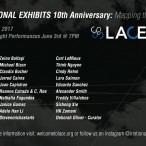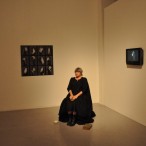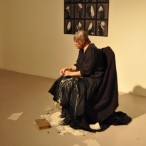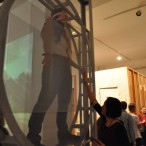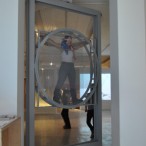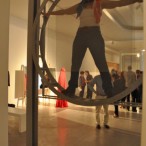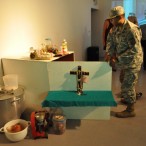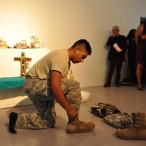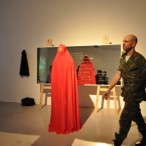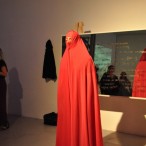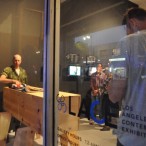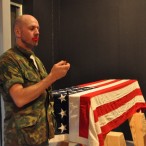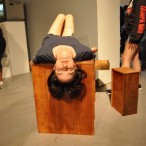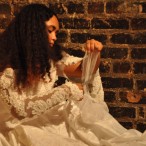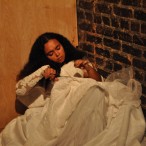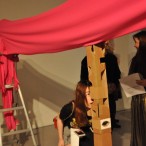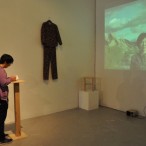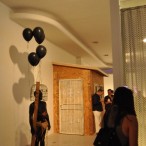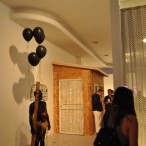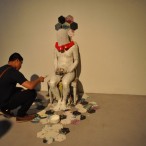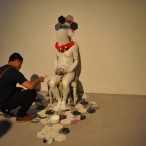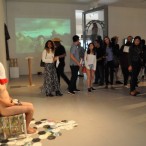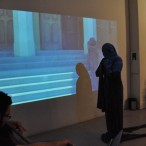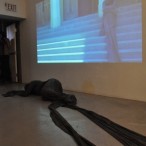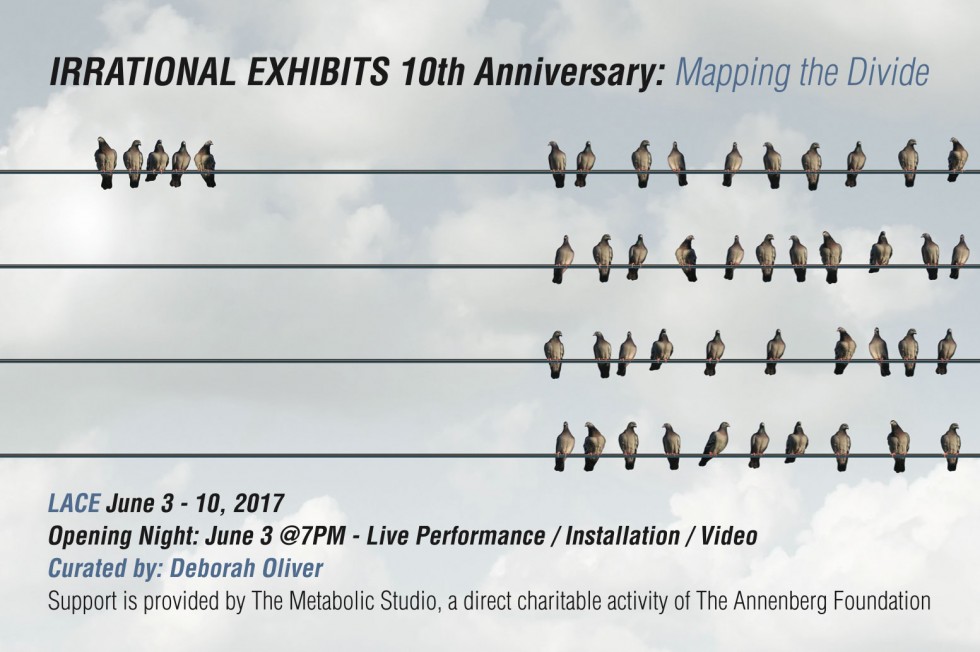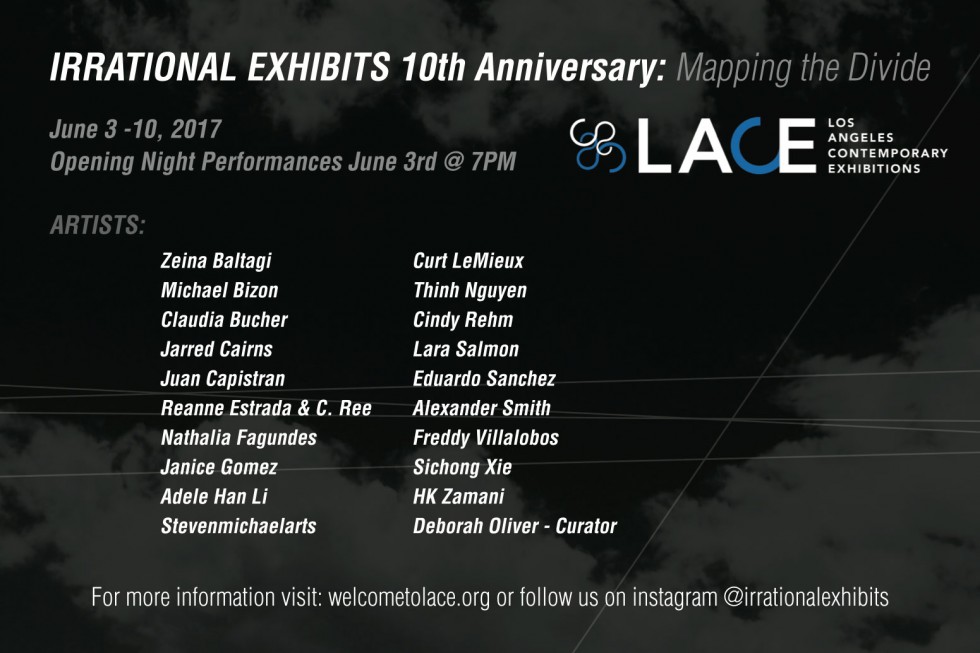Opening Performance: June 3, 2017 7-9PM
Exhibition Dates: June 4-10, 2017
Closing Performance and Reception: June 10, 2017 4-6 PM
Location: LACE
Artists:
Zeina Baltagi, Michael Bizon, Claudia Bucher, Jarred Cairns, Juan Capistran, Reanne Estrada/Chistina Rhee, Nathalia Fagundes, Janice Gomez, Adele Han Li, Steve Irvin, Curt LeMieux, Thinh Nyugen, Cindy Rehm, Lara Salmon, Eduardo Sanchez, Alexander Smith, Freddy Villalobos, Sichong Xie, and HK Zamani.
Download IE 10 Press Release (pdf)
In honor of Irrational Exhibits’ 10th Anniversary, 19 performance works will take place throughout LACE’s gallery in artist-constructed installations that function as settings for their evolving actions. Composed of diverse themes and aesthetics, all the works explore a physical engagement with the body and materials in front of the audience in real time. Although the performances will be happening simultaneously they are not the same length, giving the audience the option to move through the spaces, circulate, browse, return, or spend immersive time at their own pace, thus creating a shared experience between viewer and maker in process. Irrational Exhibits celebrates works that embrace unpredictability, the messiness of biological and organic processes and materials, and the chaos of our times.
In addition, performances from previous Irrational Exhibits will be presented alongside new works, by both repeating artists and those new to the project, thus providing a historical perspective and future directions.
During the week following the one-night performances, the installations and video works will remain on view. Lara Salmon will be performing during gallery hours, culminating on June 10th from 4-6PM.
Please join the artists in Irrational Exhibits for this one night of Live Art. Find Irrational Exhibits on Instagram – @irrationalexhibits
Essay by Jacki Apple
By the turn of the 21st century most performance art works were presented in a theatrical context before seated audiences. At the same time the accelerating growth of digital technologies, gave rise to a younger generation of viewers who were primarily consuming mediated culture through the ubiquitous screen. In response to this cultural shift, curator and producer, Deborah Oliver set out to return performance art to its process-based visual art roots by resituating it in the immersive environment of the art gallery. Hence the conception in 2001 of Irrational Exhibits as a situation in which the audience would become participating viewers free to interact in real time with a broad range of live actions of varying durations by a diverse group of artists.
Central to all these one-night events was the group show concept in which the artists each constructed installations that functioned as the settings for their evolving actions. All the performances happened simultaneously, but were not necessarily of the same length, nor were they representative of a shared aesthetic. In 21st century Los Angeles Irrational Exhibits artists represent a cross-section of ethnicities, races, cultures, and aesthetic sensibilities. What they have in common was a physical engagement with the body and materials, and the risk-taking process of making the work in front of the audience in real time.
Much like going to a museum, audiences can navigate the space at their own pace choosing their degree of engagement, with one major difference – the works they are watching are changing in front of them. They can choose to circulate, browse and return, or spend immersive time with one piece at a time. Either way creating a degree of shared experience between viewer and maker in process.
Oliver’s commitment to this structure was a response to her observation of how detached we have become from a sense of community and shared face-to-face experience in this age so dominated by media culture, and its concurrent sense of loss. Embedded in her curatorial philosophy and choices is a critique of how digital technology has distanced us from our connection to the materiality of our environment and the physicality of our own bodies and labor in the creative act of producing something out of it. Thus Irrational Exhibits celebrates works that embrace unpredictability, the messiness of biological and organic processes and materials, and the chaos of our times. It embraces the riskiness of this kind of performance art-making, and accepts the potential for failure in the act. As in real life some things turn out to be transformative and illuminating, while others do not always succeed as anticipated.
Many of the pieces presented in Irrational Exhibits have been shaped by to the history and precedents set by performance artists of the 1970’s in both Los Angeles and New York, but with their own contemporary interpretations. In Irrational Exhibits, both men and women have tested the limits of the body and physical endurance, and interacted with a wide range of organic materials and processes. Artists’ preoccupations with questions of identity, sexuality, gender, otherness and culture are as present as ever. Other artists have taken on environmental issues, popular culture, politics, competitive sports, technology and dystopian futures.
There is a raucous circus-like atmosphere that invites participation and audiences have often enthusiastically consented to taking part in an exploratory event in which all their senses are activated. As a collaborative event Irrational Exhibits is as much about being present and open to possibilities, and different ways to perceive and question the nature of our reality, as anything else. Most of all it re-establishes the position of performance art as a live interactive visual art form.
(excerpt from catalog essay)
Front Gallery:
Jarred Cairns, Kiss and Tell
Serving with honor and integrity, but not their voices, gay military members fight for our country and many have given their lives in service. Every day, they live in fear of “don’t ask, don’t tell”, of being dishonored in their profession, community and service.
Janice Gomez, tothelimit, 2005: a revisiting. Things are never the same and they never change, 2017
Gomez’s work reaches for the available — reimagining, reinterpreting, and repurposing only to hold it in a new definition for a moment; a breath, a beat, suspended. tothelimit, 2005: a revisiting. Things are never the same and they never change is a retelling of stories and gathering of new experiences. Public intimacy and trust is at the driving force of the work. Everyone is on display, flipping viewer to performer; willingly and aware. The public arena collides with the private space. Main Gallery (clockwise):
Claudia Bucher, Yaw’ll Wall, 2017
1. Yaw’ll: Eye dialect spelling of y’all. 2. Y’all: you-all 3. Yaw: noun: 1. the action of yawing; especially: a side-to-side movement 2. a movement of deviation from a direct course, as of a ship. verb: (of a moving ship or aircraft) twist or oscillate about a vertical axis. 4. Wall: noun 1. any of various permanent upright constructions having a length much greater than the thickness and presenting a continuous surface except where pierced by doors, windows, etc.: used for shelter, protection, or privacy, or to subdivide interior space, to support floors, roofs, or the like, to retain earth, to fence in an area, etc. 2. an immaterial or intangible barrier, obstruction, etc., suggesting a wall. 3. the outermost film or layer of structural material protecting, surrounding, and defining the physical limits of an object. verb: 1. to enclose, shut off, divide, protect, border, etc., with or as if with a wall (often followed by in or off). 2. to seal or entomb (something or someone) within a wall.
Adele Han, Li Chella Drive
The title of the work of the street I grew up on, located in an exurb 30 miles east of downtown Los Angeles. It winds through a community made up mostly of immigrant families who have carved out a bit of the American Dream for themselves far from the city center. It is beautiful and comfortable and pleasant — everything parents want to give their children.The film Chella Drive is my memory of the feeling of growing up there — a dreamlike juxtaposition of a teenager’s frustrated complacency and the luscious suburban environment that surrounds her. The film was made using hand drawn animations projected onto real life settings (at Chella Drive and in other suburban backyards) and rephotographed frame by frame.
HK Zamani, Scheherazade, 2007
Scheherazade I was performed in Poland in 2007. It took inspiration from Azar Nafisi’s book Reading Lolita in Tehran, and her analysis of the female protagonists in the story of 1001 Nights. The first of the Veil series was performed at the Armory in Pasadena in November of 2001. These performances are endurance based and are presented as a poignant critique of patriarchy, especially of the artist’s native Iran. They grew out of Zamani’s fabric and armature paintings and installations, and their timing corresponded with the growing fear of Islamic cultures.
Michael Bizon, Heautoscopy (Dvoynik), 2016
This work has led a double life; first as an immersive two-room installation, and now as a standalone object. Ideas of home, archive, memory and the doppelgänger are touched on through light, movement, sound and reflection.
Freddy Villalobos, AND YOU KNOW WHAT HAPPENED TO OL’ BOY
This work initially embodies melancholy and transitions into an emulsion for virtue and terror. The distance between high culture and low culture is broken by the dislocation of an urban home and gallery. The installation interrogates the quagmire space where, what is behind and what is ahead are in opposition. This creates a tension at its limits of the present and questions the possibilities of the near future.
Cindy Rehm, Phenomena of Materialisation
This performance is inspired by narratives of Victorian mediumship and the book Phenomena of Materialisation, a text that documents scientific observations of séances by the medium Eva C. between 1909 and 1914. Like women stricken with hysteria, the mediums of the early 20th century fell into trances and displayed a wide variety of erratic behavior including bodily contortions, spontaneous vocalization, automatic writing, the channeling of spirits, and materialisation of ectoplasmic forms. The medium’s altered states often revealed moments of desire that broke from the conventions of proper feminine conduct. Rehm looks to the liminal space of the trance state as a rich site for the creation and vocalization of potent female narratives.
Alexander Smith, Beast of Nations: Witness the Greatest Illusion of Our Modern Age, 2017
This work investigates caricature as a form of erasure, particularly the erasure of minority groups and struggling classes. The project investigates these illusions used as a political strategy to distract citizens, drawing parallels between events in the industrial revolution and issues contemporary to our own society. Themes of immigration, forced migration, and misogyny manifest in narratives that complicate traditional notions of right and wrong.
Eduardo Sanchez, Usted no es sola y I will not just be… 2017
Being the son of an illegal immigrant, now a citizen, I want to deconstruct the lives of illegal immigrants. Using found objects to I want to exemplify the need for work becoming one of the only defining qualities of immigrant life. How this sacrifice allows them to provide their children a better life. The confine boxes are representative of the hidden compartments some illegal immigrants had to squeeze into when crossing the border. But once the box is adorned with the found objects the box personifies those in question. Shielding the next generation inside giving it the opportunity to move away from the immigrant life and have more than just a job.
Nathalia Fagundes, Scab, 2017
“Love is so tricky damn” “I feel like everyone’s going to be married and I’ll still be single lol” “What’s up with being 25 and thinking marriage is a requirement?” Scab is a walkthrough of binaries, the institution of marriage, and the millennial desire/disinterest to settle down.
Zeina Baltagi, Take It Lying Down
The disappearance and separation of the human being inside; the anonymity in the city; what lies underneath the wreckage? So many people get lost in the concrete. Homelessness and the working class get camouflaged into the Los Angeles’ landscape. My work reveals intimate transformations from the perspective of a first-generation Lebanese-American Woman. This narrative spans my entire body of work and incorporates printmaking, painting, sculpture, filmic documentation and performance art. Whether exploring relationships with my body, transportation, employment, culture, or spirituality: my process uses lived experiences to create a living allegory of marker points. Through the process of making, I find revelations in my story.
Curt LeMieux, Preparation for a Performance That Will Never Take Place
Drawing is the foundation of my practice. Through the execution of numerous meditative sketches, I arrive at a set of personalized marks and symbols. My goal is to articulate a visual language that promotes inquiry into human behavior and ecology. I engage an archeological-like approach, wherein layers of meaning are shifted and renegotiated, allowing a rehearsal of the ways in which meanings might develop, in which behaviors become codified and understood. For Irrational Exhibits 10, I will create series of sketches for “performances” that will never take place: a large-scale drawing directly onto the gallery wall depicting the character of Betty Anne, a set of costumes that are impractical in terms of function, and a short action involving clown props and the creation of a sculptural object.
Reanne Estrada & C. Ree, Everland 2, 2017
media: glutinous suit, periscope, monitor stand on casters, ladders Everland 1 began with Koshik, a lonely elephant in a Korean zoo and amusementpark of the same name. In an attempt to connect with his zookeeper, Koshik taught himself to speak 5 Korean words by stuffing his trunk in his mouth. In Everland 2, Ree + Estrada inhabit a pink glutinous suit that spans 12 feet, conjoined at the face while perched on ladders. An unreliable periscope provides an opportunity to view the interior. The accompanying video couplets and printed matter feature excerpts from EverlandLand, a multi-modal series that explores lived-in land and the imaginary, lines of flight, the stickiness of bodies, transmissions between alternate systems of knowledge, and everyday worldmaking such as the Korean practice of dream buying/selling, fandom, and culture parks. This ongoing project has taken place in Korea, San Diego, and Los Angeles since 2015.
Lara Salmon Sincerely, America, 2017
I’m offering my body this week as a surface for you to write on. Write something you want to say to someone who has lost their home (‘a refugee’). For every opening hour of this show my skin is available to you. At the end of the exhibition I will choose one message to make permanent and will have it tattooed on my body in exactly the place and way that you wrote it. This message, from you in Los Angeles, will be delivered to peoples I meet seeking refuge.
Juan Capistran, I cannot all rebuild what so many men persist in destroying, 2013
To be happy, which means endurance, solidarity and the fight against the enemy- the only option is active revolt.
Stevenmichaelarts, ouTHOUses Version/view #2
This work with my gaze upon the homelessness and center-less problem that is plaguing our city. Where there used to be concentrated areas or locales inextricably linked to homelessness, now there is almost nowhere the issue is unavoidable in one form or another. The scourge of a mass transient community affects every single citizen, infiltrating society at large. This piece explores, embodies, and abstracts the notion of anchoring and/or tethering in a de-centralized and tumultuous environment. Devoid of familiar connection, how many remain missing or unaccounted for but for one single choice, defining moment, accident or other force of nature and will. There but for the grace of God go I …Oh brother, where Art Thou??
Thinh Nguyen, My Body Is A Battleground, 2012 This work is an endurance performance that hybridize painting, sculpture, and performance through the body as a mutable surface and form. I sat on a chair motionless while viewers painted my body with the provided brush and paint bucket. The act of painting with white paint is an act of erasure and whitewashing. My body became a contested site, a public surface for racial projections.
Sichong Xie, My Statue of Liberty subtitle: smile for an hour, 2014
I seek to be a cultural organizer who utilizes body based sculptural forms (masks/costumes/ objects) transforming discarded materials and disregarded spaces by using the tools of humor and absurdity. By placing traditional sculptural forms within new sites, materials, and social constructs, I investigate these forms, movements within global communities to re-view and re-envision shared spaces and performative practices. I utilize my persona as a mark to allow others to recognize their own form of life: I become their medium.
Curator
Deborah Oliver is an educator, independent curator, producer, and interdisciplinary artist. She is the curator of Irrational Exhibits an immersive performance/installation/video exhibition series she began in 2001 at Track 16 Gallery. The 9th edition was presented at Los Angeles Contemporary Exhibitions in June of 2016. Since the beginning of this series she has presented over 150 artists, that work in performance, installation, and video. Oliver has been on the faculty of the University of California Irvine Art Department since 1998 teaching classes in Performance Studies and New Genres. Recently she co-founded “The Art of Performance in Irvine” an annual performance event at the xMPL, Experimental Media and Performance Lab at UCI. www.irrationalexhibits.com
LACE Staff:
Sarah Russin, Executive Director; Daniela Lieja Quintanar, Curatorial Associate; Fiona Ball, Programs Manager; Andrew Freire, Operations Manager; Laurel Gregory, Curatorial Assistant for Irrational Exhibits
Support
Support for Irrational Exhibits 10th Anniversary: Mapping the Divide is provided by The Metabolic Studio, a direct charitable activity of The Annenberg Foundation
Special Thanks
Special thanks to Rochelle Fabb, LACE staff, Laurel Gregory, and the Parsons family.

